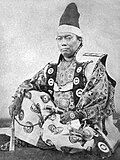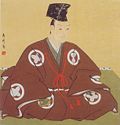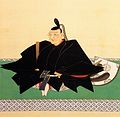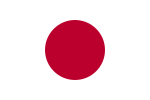Daimyo (大名, daimyō, Japanese pronunciation: [daimʲoː] ) were powerful Japanese magnates, feudal lords who, from the 10th century to the early Meiji period...
12 KB (1,300 words) - 08:33, 22 November 2024
Tozama daimyō (外様大名, "outside daimyō") was a class of powerful magnates or daimyō (大名) considered to be outsiders by the ruler of Japan during the Edo...
6 KB (709 words) - 01:10, 22 December 2024
the country, particularly smaller regions, daimyō, and samurai were more or less identical, since daimyō might be trained as samurai, and samurai might...
53 KB (5,110 words) - 02:52, 24 February 2025
Domain. Non-daimyō relatives, such as the Gosankyō, were also known as kamon – thus the shinpan lords were alternatively known as kamon daimyō (家門大名). Shinpan...
2 KB (200 words) - 13:04, 2 May 2024
Fudai daimyō (譜代大名) was a class of daimyō (大名) in the Tokugawa Shogunate (徳川幕府) of Japan who were hereditary vassals of the Tokugawa before the Battle...
11 KB (1,362 words) - 04:25, 13 November 2024
became daimyō of the Chōshū Domain under the Tokugawa shogunate. After the Meiji Restoration with the abolition of the han system and daimyō, the Mōri...
12 KB (1,353 words) - 16:10, 3 February 2025
island of Dejima in Nagasaki, beginning a period of isolation. From 1635, daimyō had to spend alternating years in the capital Edo, where their family was...
91 KB (11,182 words) - 23:50, 11 February 2025
the majority of daimyō armies, so they accounted for the majority of ronin.[citation needed] Especially in the Sengoku period, daimyō needed additional...
16 KB (1,966 words) - 19:11, 22 January 2025
This is a list of daimyōs from the Sengoku period of Japan. Nanbu Nobunao Nanbu Toshinao Tsugaru Tamenobu Date Harumune Date Terumune Date Masamune Date...
23 KB (1,202 words) - 09:42, 18 September 2024
1723–1793), Japanese daimyō Inaba Masakatsu (稲葉 正勝, 1597–1634), Japanese daimyō Inaba Masakuni (稲葉 正邦, 1834–1898), Japanese daimyō Inaba Masami (稲葉 正巳...
3 KB (423 words) - 13:09, 19 December 2019
castle consisted of samurai and daimyō residences, whose families lived in Edo as part of the sankin-kōtai system; the daimyō made journeys in alternating...
21 KB (2,613 words) - 22:34, 30 January 2025
applied to the tozama daimyō, but expanded to apply to all daimyō by 1642. One of the key goals of this policy was to prevent the daimyō from amassing too...
24 KB (2,882 words) - 14:22, 23 February 2025
Shimazu clan (category Daimyo)
of being the only daimyō family to control an entire foreign country secured the Shimazu's position as one of the most powerful daimyō families in Japan...
14 KB (1,416 words) - 01:13, 3 December 2024
rulers, later called daimyōs. In time, a balance of power evolved between the shōgun and the daimyōs; the three most prominent daimyō families rotated as...
23 KB (2,921 words) - 01:18, 9 February 2025
Kirishitan (redirect from Christian daimyo)
provided military support to Dom Justo Takayama, a Christian daimyō in western Japan. Many daimyōs converted to Christianity in order to gain more favorable...
51 KB (6,241 words) - 09:01, 4 January 2025
Tosa Domain (section List of daimyō)
and peasants fleeing to other territories. The ninth daimyō, Yamauchi Toyochika and the 13th daimyō, Yamauchi Toyoteru attempted reforms based on fiscal...
22 KB (1,530 words) - 16:13, 15 January 2025
Aizu Domain (section List of daimyō)
the shinpan daimyō of the Aizu-Matsudaira clan, a local cadet branch of the ruling Tokugawa clan, but was briefly ruled by the tozama daimyō of the Gamō...
21 KB (1,744 words) - 17:04, 26 January 2025
Mizoguchi Naoatsu (溝口 直温, 1716–1780), Japanese daimyō Mizoguchi Naoharu (溝口 直治, 1708–1732), Japanese daimyō Noriko Mizoguchi, Japanese judoka Hiroshi Mizoguchi...
907 bytes (124 words) - 18:00, 12 December 2021
Oda Nobunaga (category Daimyo)
clan and launched a war against other daimyō to unify Japan in the 1560s. Nobunaga emerged as the most powerful daimyō, overthrowing the nominally ruling...
171 KB (21,118 words) - 14:55, 24 February 2025
Edo society (section Daimyō)
the court ranks were used to control the daimyo. The daimyō were samurai feudal lords. The daimyō were high-ranking members of the samurai, and, similar...
24 KB (2,885 words) - 10:59, 10 May 2024
Shimazu Nariakira (category Tozama daimyo)
Nariakira (島津 斉彬, April 28, 1809 – August 24, 1858) was a Japanese feudal lord (daimyō) of the Edo period, the 28th in the line of Shimazu clan lords of Satsuma...
22 KB (2,713 words) - 14:48, 7 October 2024
Asano Naganori (category Daimyo)
Asano Naganori (浅野 長矩, September 28, 1667 – April 21, 1701) was the daimyō of the Akō Domain in Japan (1675–1701). His title was Takumi no Kami (内匠頭)....
5 KB (591 words) - 12:11, 1 February 2025
Toyotomi Hideyoshi (category Daimyo)
Tōkichirō (木下 藤吉郎) and Hashiba Hideyoshi (羽柴 秀吉), was a Japanese samurai and daimyō (feudal lord) of the late Sengoku and Azuchi-Momoyama periods and regarded...
65 KB (7,043 words) - 00:32, 19 February 2025
A daimyō collection is a collection mostly of the property or former property of daimyō, or feudal aristocrat families of Japan, which are now open to...
3 KB (336 words) - 06:38, 6 January 2025
capital of Heian-kyō (Kyoto) as de facto military dictators along with the daimyō lords of the samurai class. The Ashikaga shogunate began the Nanboku-chō...
15 KB (1,526 words) - 11:17, 10 January 2025
were all daimyō chosen due to their relation to the taikō and the amount of power they held in the country. Hideyoshi chose powerful daimyō to prevent...
32 KB (4,311 words) - 17:41, 5 February 2025
(1665–1705) 4th daimyō of Kishū and married Tsuruhime, daughter of 5th shōgun Tokugawa Tsunayoshi Jirokichi Tokugawa Yorimoto (1680–1705) 5th daimyō of Kishū...
13 KB (1,371 words) - 05:01, 19 December 2024
term for the estate of a daimyo in the Edo period (1603–1868) and early Meiji period (1868–1912). Han or Bakufu-han (daimyo domain) served as a system...
11 KB (969 words) - 12:44, 28 October 2024
rose to become a samurai under Tokugawa Ieyasu, a powerful feudal lord (daimyō) who later became the military ruler of Japan (shōgun) and the founder of...
115 KB (6,587 words) - 02:32, 24 February 2025
actual power was held by military dictators (shōgun) and feudal lords (daimyō), and enforced by warrior nobility (samurai). After rule by the Kamakura...
201 KB (16,451 words) - 04:03, 24 February 2025




















